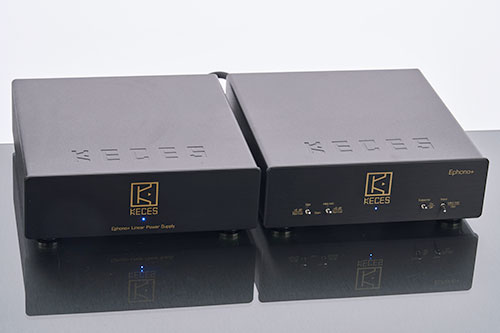
The two rear sections each contain six capacitors with a total capacity of 132,000 microfarads per channel. They are each connected by three curved copper rails with a thickness of five millimetres. These alone would be reason enough to give the power amplifier a smoked glass panel instead of a metal cover, revealing the power amplifier's technology. The two bipolar output transistors of each channel are only a few centimetres away from their power supply. As Hervé Delétraz explains at length in the operating instructions, he is not a fan of symmetrical signal processing, since music, i.e. sound waves, do not move air, but are vibrations of air molecules, and behave asymmetrically. Based on these considerations, he has also chosen an unbalanced circuit for his power amplifier. Since he did not want to do without an XLR input, he is unbalancing the signal without reference to the ground by means of a transformer. At this point, I vividly recall the frequent discussions with my colleague Wojciech Pacuła and the interview with Michael Børresen, the developer of Aavik's C-880 and P-880, which, although partly with different arguments, agree with the darTZeel boss on the matter – unlike the author. In fact, some of Hervé Delétraz's strongly worded descriptions of technical solutions or their justifications could be passionately discussed – even if they seem extremely conclusive to me in their consequences. Be that as it may, what is crucial is in the listening room.

At first the darTZeel NHB-108 in my chain takes the place of Einstein's The Poweramp – admittedly an unfair comparison, as you could get about three Einsteins for the price of the Swiss power amplifier. Incidentally, both power amps draw their energy from Audioquest's Niagara 5000 and the line signal is transmitted via a balanced Dragon cable – even though this is not the connection favoured by darTZeel. Nevertheless, the NHB-108 is immediately convincing, even without a longer warm-up phase. During the first few minutes, I am sure that it performs at least at the same level as my standard power amplifier. But soon it becomes clear that the darTZeel has more to offer: especially in the low-frequency range, it simply produces a little more pressure – very pleasantly! But the NHB-108 doesn't just release more energy, it also does so in a highly controlled and precise manner.

-
Keces Ephono+
Nein, ich werde mich ab sofort nicht mehr nur mit günstigen Hifi-Komponenten beschäftigen, auch wenn durch den Test des erschwinglichen Eversolo DAC-Z10 und des Ephono+ der Eindruck entstehen konnte. Denn obwohl Keces der Signalverarbeitung und dem Netzteil je ein eigenes Gehäuse spendiert, ist die Phonostufe für gerade einmal 1.200 Euro zu haben. Ich habe zwar gegenüber Komponenten mit moderaten Preisen genau so wenig Berührungsängste wie gegenüber solchen mit exorbitant hohen – wie sich Anfang des…23.12.2025 -
Galion Audio Navy Röhrenvorverstärker
Wir haben das röhrenbestückte Vorverstärker-Flaggschiff Navy des jungen kanadischen HiFi-Unternehmens Galion Audio unter die Lupe genommen. Der Line-Vorverstärker mit vier Doppeltrioden 12AT7 (ECC81) wartet nicht nur mit hochwertigen Bauteilen auf, sondern er ist das spannende Designprodukt eines high-fidelen Überzeugungstäters. Mir sagte der Markenname Galion Audio bislang wirklich gar nichts. Das junge Unternehmen aus Québec in Kanada wurde 2020 von Thomas Tan, einem passionierten Audiophilen, YouTuber („Thomas & Stereo“) und Content Creator, gegründet. Ziel war, seine…16.12.2025 -
Eversolo DAC-Z10
Meine beiden D/A-Wandler, der DAVE im Arbeits- und der HUGO TT2 im Wohnzimmer, werden serienmäßig von Schaltnetzteilen gespeist. Bei letzterem kommt seit einiger Zeit ein Ferrum Hypsos, bei Chord Electronics Topmodell ein lineares Dreifach-Netzteil zum Einsatz. Ein solches versorgt auch den Eversolo DAC-Z10 – zum Preis von 2.000 Euro. Und nein, es sind keine drei ausgelagerten Stromversorgungen, für die der genannte Preis gilt. Dafür bekommt man das vollständige Topmodell unter Eversolos DACs. Es ist schon…09.12.2025 -
Raidho X2.6 Standlautsprecher
Mit Lautsprechern von Raidho haben wir uns bei Hifistatement schon öfter beschäftigt. Im Fokus standen dabei die Kompaktlautsprecher TD1.2 aus der TD-Serie sowie X1t und X1.6. aus der X-Serie. Diesmal haben wir den Standlautsprecher X2.6 zu Gast, das aktuell größte Modell der X-Serie. Raidho verspricht, mit der X-Serie besonders viel Leistung – sprich Klangqualität – für den aufgerufenen Preis zu bieten. Wobei, „billige“ Lautsprecher – ganz gleich nach welchem Maßstab - hat Raidho noch nie…02.12.2025 -
Canor Virtus A3
Zur diesjährigen HighEnd stellte Canor den Virtus A3 Hybrid-Vollverstärker vor. Der lockt mit einem integrierten Digital-Analog-Wandler und einer diskret aufgebauten Phono-Vorstufe für MM- und MC-Tonabnehmer. Sowohl seine Technik als auch die Ausstattung bieten Ungewöhnliches. Vor allem aber soll er klanglich beeindrucken. Das slowakische Entwickler-Team konnte mich bereits vor einem Jahr überzeugen: Der Vollverstärker Virtus I2 aus der Premium Line musizierte in meinem Hörraum wie keiner zuvor in dieser Preisklasse. Der war ein gestandener Röhren-Vollverstärker. Auch…28.11.2025 -
Dan D’Agostino Progression S350
Dan D’Agostino ist eine Legende im Verstärkerbau. Er folgte wohl nie einer Mode, sondern vertraut bei allen Entwicklungen seinem Gehör und seiner Leidenschaft für den guten Klang. Mehr als 50 Jahre baut er nun schon Verstärker, immer mit dem Ziel, das „Wesen der Musik hörbar zu machen“. Erfüllt auch der S350 diese hoch gesteckten Ambitionen? Die Progression S350 ist die kleinste Stereoendstufe im Gesamtprogramm. Optisch trägt sie alle charakteristischen Merkmale einer echten D’Agostino. Angefangen mit…25.11.2025
© 2025 | HIFISTATEMENT | netmagazine | Alle Rechte vorbehalten | Impressum | Datenschutz

























 |
|















































































